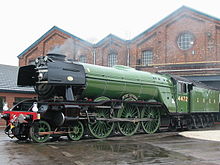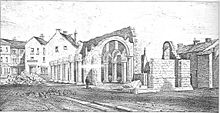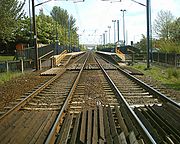Doncaster
| Doncaster | ||
|---|---|---|
| St George's Minster | ||
| Coordinates | 53 ° 31 ′ N , 1 ° 8 ′ W | |
|
|
||
| Residents | 67,977 (as of 2001 ) | |
| administration | ||
| Post town | DONCASTER | |
| ZIP code section | DN1-DN12 | |
| prefix | 01302 | |
| Part of the country | England | |
| region | Yorkshire and the Humber | |
| Metropolitan county | South Yorkshire | |
| Metropolitan Borough | Doncaster | |
| British Parliament | Doncaster Central | |
| Website: http://www.doncaster.gov.uk/ | ||
Doncaster is a middle town in the English county of South Yorkshire and the administrative seat of the Metropolitan Borough of Doncaster . According to the 2001 census, Doncaster had 67,977 residents.
geography
Doncaster is the second largest city in South Yorkshire after Sheffield (30 km away). The distance to London is around 250 km.
history
Antiquity
A Roman fort called "Caer Daun" was built in the first century AD at Doncaster's current location on the banks of the Don River . Later its name was changed to "Danum", from which the present city received the name part Don- . The ending -caster comes from the Latin name for military camp ("castrum").
Doncaster was the site of an equestrian garrison from Crispus , the eldest son of Constantine the Great .
In ancient times, an alternative route ran through Doncaster from Lincoln to York . In order to use the main route Ermine Street , the Humber was crossed by boats. Over time, however, due to increasing transport needs, this became more and more impractical, giving Doncaster a greater prominence on Roman maps.
Today there are many sites of archaeological interest, some of which are under building foundations. The presumed exact location is at St George's Minster on the banks of the Don.
middle Ages
In 1003, Doncaster was mentioned in the Wulfric ridicule . Shortly after the Norman conquest of England , General Nigel Fossard had the city fortified and Doncaster Castle built.
During the 12th century in particular, the city grew, and in 1194 King Richard I granted Doncaster town charter . The city continued to prosper in the following years and was only slowed down for a short time by a devastating city fire in 1204.
In 1248 the city was given the right to hold a market around the church of St. Maria Magdalena, which still exists today. The church building was converted into the town hall in the 16th century and finally demolished in 1846. The market also includes a 19th century grain exchange , the building of which was built in 1873 and rebuilt in 1996 after a fire.
Large numbers of monks gathered in Doncaster during the fourteenth century. In 1307 Franciscan monks arrived in the city, followed by the Carmelites in the middle of the century . During the Middle Ages, numerous facilities such as the St. Nicholas Hospital as well as a leper colony and grammar school opened. In 1334 Doncaster was the wealthiest city in southern Yorkshire and the sixth most important city in Yorkshire. In 1379, after several years, it quickly recovered from the effects of the Black Death and at that time had 1500 inhabitants. In 1547 the 2000-inhabitant mark was exceeded.
Today many streets end with the suffix 'gate'. The ending comes from the old Danish 'gata' for street. Traders and craftsmen in the same industry usually lived on the same street, and this is how street names such as 'Baxtergate' came about: 'Baxter' was an old word for baker, which means the name can be translated as Bäckerstraße. It is believed that the name 'Frenchgate' comes from the French-speaking Normans who lived on this street. The medieval city center of Doncaster was surrounded by a city wall including a moat and had four city gates. In 1605, King James I granted the Levett family of merchants from York the right to collect customs duties at the city gates. With the growing influence of the family in Doncaster City Council, the customs duties rose in the following years, so that the local population began to rebel against it from 1628. In the end, the tariffs were abolished by the city parliament despite resistance from the Levett clan.
Despite several epidemic outbreaks in the period from 1562 to 1606, the city was able to expand further in the 16th and 17th centuries.
English Civil War
During the English Civil War , King Charles I traveled to Doncaster via Bridgnorth , Lichfield and Ashbourne . On August 18, 1645, a large number of people gathered there at his instigation. On May 2, 1664, Doncaster was awarded the title of "Free Borough", whereby the king expressed his gratitude for the attachment of the city to him.
Doncaster and its borough have traditionally been very wealthy since the 18th century and are known for their large number of large landowners. Visible signs of this are well-known buildings such as Brodsworth Hall, Cantley Manor, Cusworth Hall, Hickleton Hall, Nether Hall and Wheatley Hall. The most distinctive building in the city is St George's Minster .
politics
The city belongs to the constituency of Doncaster Central and is represented in the House of Commons by Rosie Winterton ( Labor Party ) .
At European level, Doncaster was a member of the Yorkshire and the Humber constituency of the European Parliament , most recently represented by six MEPs.
Sports
Horses have been bred in Doncaster since the 16th century and later also for racing. The first major racing event at Doncaster Racecourse was the Doncaster Gold Cup, first held in 1766, and the St. Leger Stakes ten years later . The Cup is the oldest continuously held equestrian competition in the world. During World War II, the Racecourse was used for military purposes and the racing events from 1915 to 1918 by Newmarket in County Suffolk laid.
The city's football club is called Doncaster Rovers . The men's team currently plays in Football League One , the third highest division in professional football. The women's team Doncaster Rovers Belles even plays in the top division, the FA Women's Super League . Since 2007, both teams have played their home games in the newly built Keepmoat Stadium , which can hold 15,231 spectators .
Doncaster RFC is a third division rugby union club with home games in Castle Park. In 2008, a new stadium grandstand with a capacity of 1650 was inaugurated. The Doncaster RLFC is a rugby league club that plays in the 2nd division and plays its games in the 15,231-seat Keepmoat Stadium.
Doncaster also owns the Doncaster Panthers basketball club and the Doncaster Mustangs American football club.
In 1991 and 1992 the World Matchplay in snooker took place in The Dome .
Economy and Infrastructure
From the late 18th to the 20th centuries, Doncaster developed into an industrial center. The good accessibility by land and water led to enormous growth and a high proportion of migrants. There are large deposits of coal seams below the city .
Because of Doncaster's good transport connections, various mail order companies have settled here. For example, there is an international freight company that transports goods across Europe by rail. Resident department stores are Next , Tesco , Ikea , Exel , Fabergé and B&Q . On March 5, 2004, Doncaster was awarded the Fair Trade seal (see Fair Trade City ).
Coal mining

The coal was essential for the population growth of the city in the industrial age. The Don was used as a water transport route for coal to the steel mills in Rotherham , Scunthorpe and Sheffield . In addition to coal mining, various industries that are dependent on it settled there, such as B. the glass production , the chemical industry , the steel industry and the wire rope production .
Due to the decline of coal mining in the 1980s, many jobs were lost and all traces of coal mining except for a handful of mines were removed. Many industries dependent on coal production were also affected by this decline.
Railway industry
With the industrial revolution , the railroad arrived in Doncaster. In 1853, the Great Northern Railway opened a large railway works. In order to be able to offer the growing workforce and their families adequate accommodation, an extensive housing construction program was started, which also included the construction of a church, the St James Church , and a school ( St. James' School ). The railway plant became internationally known for its production of the Pacific steam locomotives Mallard and Flying Scotsman as well as thousands of other steam locomotives. During the First and Second World Wars , the railway plant was converted into an ammunition plant. From the beginning of August 2008, the entire facility was demolished. Parts of it have been replaced by a large housing estate. The Wabtec company continues to operate passenger coach maintenance services on the site of the former Aw Doncaster.
aviation
In 1909, Doncaster Racecourse was chosen to host an air show. The first air show took place a year earlier in Reims, France. In Doncaster all the leading aviation pioneers were present. However, while trying to win the Daily Mail's award for flying within a square mile, Samuel Franklin Cody had an accident on the runway. During the First World War, the area was used as a base for aircraft defending the British east coast against zeppelins , but no intruders could be detected. The Royal Flying Corps trained pilots for aerial battles over France from the base near Doncaster. Within months of the war, the plant was sold to an engine manufacturer in Sheffield. In the 1970s all buildings on the site were demolished and a modern housing estate was built.
In the 1920s the British government decided to create a network of civil airfields for the population. On May 26, 1934, the first civil airfield finally opened near Doncaster. The first international air connection to Amsterdam was established on July 1, 1936.
On November 1, 1938, the 616 squadron was formed, which played an important role in the Battle of Britain from here. The squadron was the first to be equipped with the Gloster Meteor and had the task of putting German Fieseler Fi 103 missiles out of action. In 1944, the squadron's planes were replaced by American Douglas DC-3s , which then took part in Operation Overlord .
After the war, the airfield was again used for civilian purposes before it was finally closed in 1992.
Manufacture of agricultural machinery
In 1939 International Harvester started producing agricultural machinery in Doncaster. Tractors were first mass-produced in 1949. Initially, production parts were imported from the USA, but later the company premises were expanded and the production of the parts was taken over. 1953 began with the production of bulldozers. From 1960, various tractor models were produced in series for the British and continental European markets. Since the acquisition of International Harvester by Case Corporation in 1985, the agricultural machinery has been marketed under the Case IH brand name . In 1999 the 350,000 left the Doncaster plant. Tractor the production line.
In 2000 the plant was taken over by the Italian Argo group and in 2001 the new tractor manufacturer McCormick Tractors International was founded. The plant now employed around 380 people. In December 2006, just one week before Christmas, the group of companies announced the closure of the Doncaster plant and the relocation of production to Italy for mid-2007. The closure resulted in the loss of 325 jobs and 61 years of agricultural machinery production in Doncaster.
traffic
South of the city, the M18 and A1 (M) motorways intersect at Wadworth junction. The M18 is a 20-minute drive north on the M62 ( Liverpool - Hull ) and south-west on the M1 ( London - Leeds ). "A1 (M)" refers to sections of the A1 trunk road that has been developed to motorway standard and runs from London to Edinburgh . Leading through the city Doncasters A-roads are the A18 , A19 , A60 , A635, A638, A639 and A6182.
Most of Doncaster's inner city bus routes are operated by First , closely followed by Stagecoach . Other operators are Wilfreda Beehive , Veolia Transport and Arriva Yorkshire .
The Don , which flows through the city, is navigable from Sheffield down to Doncaster. From here to the confluence with the Ouse , shipping traffic is shifted to a canal running parallel to the river.
The station Doncaster is affected by the following train connections:
| begin | target | society |
|---|---|---|
| London King's Cross | Edinburgh Waverley | London North Eastern Railway |
| London King's Cross | Leeds | London North Eastern Railway |
| Doncaster | Leeds | Northern Trains |
| Sheffield Midland | Hull Paragon | Northern Trains |
| London St Pancras | Leeds | East Midlands Railway |
| Doncaster | Lincoln Central | Northern Trains |
| Cleethorpes | Manchester Airport | First Transpennine Express |
| London King's Cross | Hull Paragon | First Hull Trains |
| Plymouth | Edinburgh Waverley | CrossCountry |
| Reading | Newcastle Central | CrossCountry |
Doncaster / Sheffield Airport is ten kilometers southeast of the city center and opened on April 28, 2005. Until 1994 the area was used as a military airfield by the Royal Air Force . In its first year of operation, the airport was used by over 900,000 passengers. Other airports in the region include Humberside Airport (60 km), Manchester Airport (80 km), Leeds / Bradford Airport (80 km) and East Midlands Airport (100 km away).
Personalities
sons and daughters of the town
- John Frederick Herring junior (1820–1907), painter
- Robert Dudley Baxter (1827–1875), political economist
- John Collinson (1859–1901), officer and colonial administrator
- Barbara Euphan Todd (1890–1976), writer
- Anthony Barber (1920–2005), politician
- Bruce Woodcock (1921-1997), professional boxer
- Diana Rigg (born 1938), actress
- Martin N. Wilson (* 1939), particle physicist
- Alun Armstrong (born 1946), actor
- Mark Ryan (born 1956), actor
- Jeremy Clarkson (* 1960), journalist
- Emma Chambers (1964-2018), actress
- Jacqueline Macaulay (born 1967), actress
- Sion Llewelyn Simon (* 1968), politician
- Mick Whitnall (* 1968), guitarist for the Babyshambles
- Edward Hogg (born 1979), actor
- Anna Tunnicliffe (* 1982), sailor
- Tan France (born 1983), television personality
- John Escreet (* 1984), jazz pianist
- Danny Rose (* 1990), soccer player
- Louis William Tomlinson (* 1991), soccer player and singer with One Direction
- Mason Holgate (born 1996), soccer player
- Yungblud (* 1997), musician
Individual evidence
- ^ A b David Hey: Medieval South Yorkshire . Landmark Pub., Ashbourne 2003, ISBN 1-84306-080-9 (English).
- ↑ http://public-art.shu.ac.uk/pmsa/doncaster/00000046.htm Corn Exchange Public Art (with details of construction date)
- ^ Collections of the Maine Historical Society, James Phinney Baxter, Maine Historical Society, Portland, 1893
- ↑ World Matchplay ( Memento February 28, 2012 in the Internet Archive ) on Chris Turner's Snooker Archive. Retrieved April 6, 2012
- ^ Larkin: The Railway Workshops of Britain, 1823-1986 . Macmillan, London, ISBN 0-333-39431-3 , OCLC 59095511 .
- ^ The Roar of Dust and Diesel A story of International Harvester Doncaster , by Mike Teanby, pub by Japonica press in 2004. ISBN 1-904686-06-0
Web links
- Doncaster Council (English)









